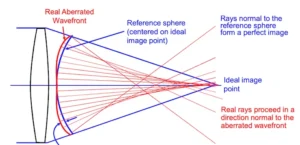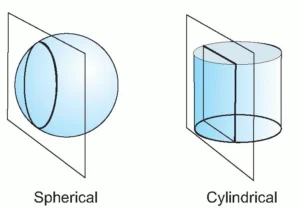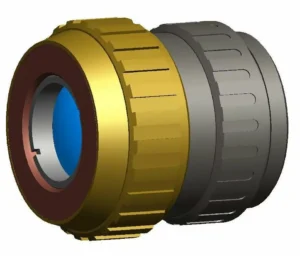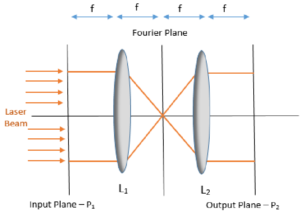STVZO (Straßenverkehrs-Zulassungs-Ordnung) is one of the most critical standards in the realm of bicycle lighting, ensuring compliance with legal requirements while enhancing the safety and convenience of cyclists. Adhering to these stringent standards is essential for providing effective illumination and meeting the necessary regulations for bike lights.
Designing an STVZO-compliant light involves a deep understanding of its pattern and optical design criteria, which ensure that the light does not blind oncoming traffic while providing adequate illumination for the cyclist. In this article, we will delve into the complexities of the STVZO bike light pattern, the optical design challenges, and how companies like Magnic Light are pioneering advancements in this field.
The Importance of STVZO Compliance
STVZO compliance is crucial for bike lights used in public roadways in Germany and many other European countries. This regulation specifies that bike lights must have a clear cutoff line to prevent dazzling other road users, focusing the light on the path ahead rather than into the eyes of oncoming cyclists and motorists.
Key Requirements of STVZO Bike Lights:
- Cutoff Line: The light must have a well-defined horizontal cutoff to prevent glare.
- Illumination Range: The light should provide sufficient illumination over a specified range to ensure visibility.
- Intensity Distribution: The light intensity must be distributed to maximize road visibility while minimizing wasted light.
These requirements ensure that bike lights provide the necessary illumination for safe riding while being considerate of other road users. FIgure 1. STVGO requires a cutoff line.
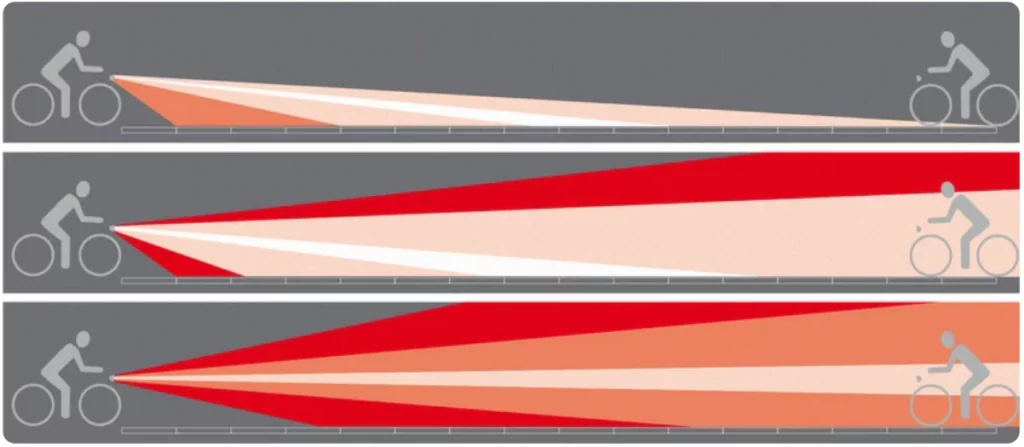
Optical Design of STVZO Bike Lights
The optical design of STVZO-compliant bike lights involves creating a precise beam pattern that adheres to the regulations. This process includes designing lenses and reflectors to shape the light beam appropriately.
Design Elements:
- Lens Design: The lens must focus the light to create a sharp horizontal cutoff. This involves detailed calculations and simulations to ensure the light is distributed correctly.
- Reflector Geometry: Reflectors are designed to direct the light from the source through the lens in a controlled manner. The shape and coating of the reflector play a crucial role in achieving the desired beam pattern.
- LED Placement: The position and orientation of the LED within the housing are critical. Even minor deviations can significantly affect the beam pattern.
To illustrate, companies like Magnic Light have developed innovative solutions that leverage magnetic induction to power bike lights without batteries, maintaining compliance with STVZO standards while offering a unique value proposition.
Challenges in Meeting STVZO Requirements
Designing a light that meets STVZO requirements is no small feat. The optical design must consider several factors to ensure compliance:
- Precision Manufacturing: The lenses and reflectors must be manufactured to precise specifications. Any imperfection can lead to non-compliance.
- Thermal Management: LED lights generate heat, which can affect their performance and longevity. Efficient thermal management systems are necessary to maintain light quality.
- Durability: Bike lights must withstand various environmental conditions, including rain, dust, and vibrations.
Case Study: Magnic Light
Magnic Light has emerged as a frontrunner in the bike lighting industry with its groundbreaking approach to bicycle illumination. Leveraging the principles of magnetic induction, Magnic Light’s products are distinguished by their ability to generate power without any direct physical contact. This revolutionary technology eliminates the need for batteries, providing a constant and reliable light output that is both environmentally friendly and user-convenient. The integration of magnetic induction in bike lights marks a significant leap forward in the domain of sustainable and efficient cycling accessories.
Innovative Technology
At the heart of Magnic Light’s innovation is magnetic induction. Traditional bike lights often rely on battery power or dynamo systems, which have their respective limitations, including maintenance issues and energy inefficiencies. In contrast, Magnic Light’s system harnesses the energy generated by the motion of the bike wheels passing by magnets embedded in the light fixture. This process induces an electric current without direct contact, thereby producing light. Key Advantages of Magnetic Induction:
- No Batteries Required: Eliminates the need for battery replacements, reducing waste and maintenance efforts.
- Consistent Power Supply: Provides a steady light output irrespective of the battery level, ensuring continuous visibility.
- Eco-Friendly: Reduces environmental impact by eliminating disposable batteries and utilizing sustainable energy generation methods.

Optical Design Excellence
Magnic Light’s commitment to excellence is evident in the meticulous optical design of their products. The lenses and reflectors are precisely engineered to conform to the stringent requirements of the STVZO standards. These components are crucial in shaping the light beam to achieve the desired pattern and intensity distribution.
Lens Design: The lenses used in Magnic Light’s products are designed to focus the light efficiently, creating a sharp horizontal cutoff that prevents glare. This design ensures that the light is directed where it is needed most—on the road ahead—while minimizing the potential for blinding oncoming traffic. Reflector Geometry: The reflectors are crafted with precision to reflect the maximum amount of light from the LEDs through the lenses.
The shape and coating of the reflectors are optimized to enhance the light output and ensure a uniform beam pattern. This precise control over the light distribution is key to meeting STVZO standards. LED Placement: The position and orientation of the LEDs within the housing are critical for achieving the desired light pattern. Magnic Light ensures that each LED is placed accurately to maximize efficiency and compliance with regulations.
Durability and Reliability
Magnic Light’s products are designed to withstand the rigors of everyday use and various environmental conditions. The durability of these lights is a testament to the quality of materials and the robustness of the design.
Weather Resistance: Magnic Light’s bike lights are built to be waterproof and dustproof, ensuring reliable performance in all weather conditions. This resilience is crucial for cyclists who ride in diverse environments, from urban streets to rural trails. Thermal Management: Effective thermal management is vital for maintaining the performance and longevity of LEDs.
Magnic Light incorporates advanced thermal management systems to dissipate heat efficiently, preventing overheating and ensuring consistent light output. Mounting Versatility: The lights are designed with versatile mounting options to accommodate different types of bicycles. This flexibility makes it easy for cyclists to install and adjust the lights according to their specific needs.
User Experience and Feedback
Magnic Light places a strong emphasis on user experience, ensuring that their products are not only functional but also convenient and easy to use. Customer feedback plays a crucial role in the continuous improvement of their products.
Ease of Installation: The lights are designed for easy installation without the need for specialized tools or technical expertise. This user-friendly approach ensures that cyclists can quickly and securely mount the lights on their bikes. Customer Support: Magnic Light provides robust customer support to address any issues or concerns that users might have.
This commitment to customer satisfaction helps build trust and loyalty among their user base. Positive Reviews: Users have praised Magnic Light for the reliability, performance, and innovative design of their products. The positive reviews highlight the effectiveness of the lights in providing clear and consistent illumination, as well as the convenience of not having to worry about battery replacements.
The Role of Simulation in Optical Design
Simulating the light pattern is a crucial step in the design process. Advanced software tools allow designers to model the light’s behavior and make adjustments before physical prototypes are created. These simulations can predict how the light will be distributed, ensuring compliance with STVZO standards.
Steps in the Simulation Process:
- Initial Design: Creating an initial design based on theoretical calculations.
- Simulation: Running simulations to visualize the light pattern.
- Adjustments: Making necessary adjustments to the design based on simulation results.
- Prototyping: Creating physical prototypes to validate the design.
- Testing: Conducting real-world tests to ensure compliance.
Link to Related Reading
For those interested in the broader context of roadway lighting and its optical requirements, Difficulty of optical requirements for roadway lighting, ranked | OFH provides an excellent overview. This resource ranks the challenges of meeting various optical requirements, offering valuable insights for anyone involved in designing lighting solutions.
Practical Considerations in STVZO-Compliant Light Design
Designing an STVZO-compliant bike light involves practical considerations beyond the optical design. These include ensuring the light is robust enough for daily use and easy to install on various bicycle models.
Factors to Consider:
- Mounting Options: The light should be easily mountable on different types of bicycles.
- Weather Resistance: The light should be waterproof and dustproof to withstand different weather conditions.
- Battery Life: For battery-operated lights, ensuring a long battery life is essential.
Conclusion
Creating an STVZO-compliant bike light is a multifaceted challenge that combines advanced optical design with practical considerations for everyday use. Companies like Magnic Light have pioneered innovative solutions that not only meet regulatory standards but also enhance the overall cycling experience. Through precise lens design, reflector geometry, and robust simulation processes, these lights provide the necessary illumination while ensuring the safety of all road users.
For further insights into the complexities of optical requirements in roadway lighting, refer to the article on Difficulty of optical requirements for roadway lighting, ranked | OFH. Understanding these challenges provides a deeper appreciation for the engineering involved in creating effective and compliant lighting solutions.
References
- STVZO Requirements and Standards
- Magnic Light Official Website
- Difficulty of optical requirements for roadway lighting, ranked | OFH
FAQ: Understanding STVZO Bike Light Pattern and Optical Design
What is STVZO and why is it important for bike lights?
STVZO (Straßenverkehrs-Zulassungs-Ordnung) is the German road traffic licensing regulation that sets specific requirements for vehicle components, including bicycle lights. Compliance with STVZO is important because it ensures that bike lights provide adequate illumination for the cyclist without dazzling oncoming traffic. Adhering to these standards enhances safety for both cyclists and other road users.
What are the key optical design elements required for STVZO compliance?
To meet STVZO standards, bike lights must have a well-defined horizontal cutoff line to prevent glare, sufficient illumination range, and an optimized intensity distribution. Key optical design elements include:
• Lens Design: Focuses the light to create a sharp horizontal cutoff.
• Reflector Geometry: Directs the light through the lens to shape the beam pattern.
• LED Placement: Ensures precise positioning of LEDs to achieve the desired light distribution.How does Magic Light’s magnetic induction technology work?
Magnic Light’s magnetic induction technology generates power through the motion of the bicycle wheels. As the wheels pass by magnets embedded in the light fixture, an electric current is induced without any direct contact. This innovative approach eliminates the need for batteries, ensuring a constant and reliable light output. The system is eco-friendly and maintenance-free, providing a sustainable lighting solution for cyclists.
What are the advantages of using Magnic Light’s bike lights?
Magnic Light’s bike lights offer several advantages:
• Battery-Free Operation: Eliminates the need for batteries, reducing waste and maintenance.
• Consistent Light Output: Provides a steady and reliable light source.
• Eco-Friendly: Utilizes sustainable energy generation through magnetic induction.
• Durability: Built to withstand various environmental conditions, including rain and dust.
• User Convenience: Easy installation and maintenance-free operation.How do Magnic Light’s products ensure compliance with STVZO standards?
Magnic Light ensures compliance with STVZO standards through precise engineering of their optical components. Their lenses and reflectors are meticulously designed to create the required beam pattern with a clear horizontal cutoff. Advanced simulation and testing processes validate that the light output meets the regulatory requirements. Additionally, the durable construction and efficient thermal management systems contribute to the reliability and performance of the lights.
Further reading:
Difficulty of optical requirements for roadway lighting, ranked Expanding Zemax Capabilities, 3 example advanced macros and custom Dlls PowerPoint (opticsforhire.com)

